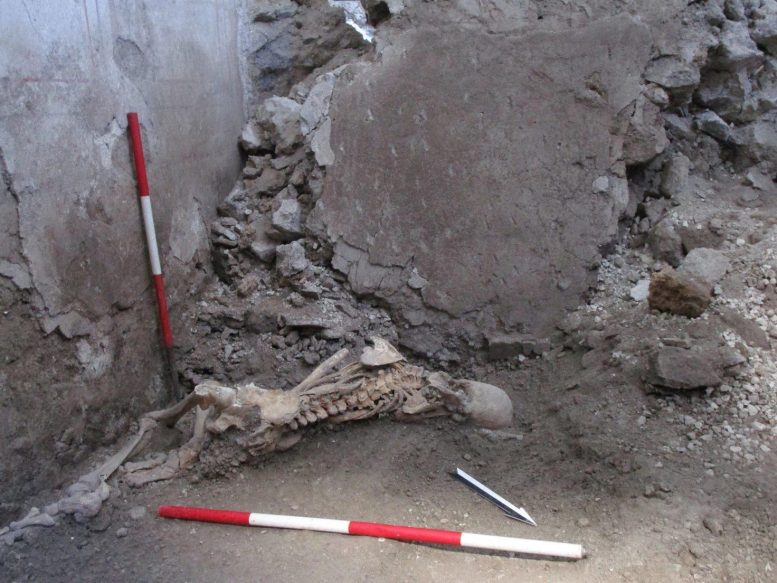New Study Reveals Earthquakes' Surprising Influence on Pompeii's Destruction

Researchers have provided new insights into the destructive forces of both earthquakes and the volcanic eruption of Mount Vesuvius in 79CE, which led to the tragic end of Pompeii. Their findings highlight the significant impact of seismic activities alongside volcanic phenomena on the city and its people. Skeleton of ‘individual 1’, a male aged around 50 years. The positioning suggests he was suddenly crushed by the collapse of a large wall fragment, resulting in severe traumas causing immediate death. Credit: Pompeii Archaeological Park
New research shows earthquakes significantly contributed to Pompeii’s devastation during Vesuvius’s 79CE eruption.
Nearly 2,000 years ago, Pliny the Younger wrote letters describing a shaking ground as Vesuvius erupted. Now, researchers from the Istituto Nazionale di Geofisica e Vulcanologia (INGV) and Pompeii Archaeological Park have provided new insights into the effects of seismicity associated with the 79CE eruption.
The research, recently published in Frontiers in Earth Science, is the first to investigate the effects of co-occurring earthquakes during the eruption. This is a difficult task since volcanic and seismic effects may happen concurrently or in quick succession, where one can obscure the effects of the other.
Location of the skeletons found in room A. Credit: Pompeii Archaeological Park
“These complexities are like a jigsaw puzzle in which all the pieces must fit together to unravel the complete picture,” said first author Dr Domenico Sparice, a volcanologist at INGV-Osservatorio Vesuviano. “We proved that seismicity during the eruption played a significant role in the destruction of Pompeii and, possibly, influenced the choices of the Pompeiians who faced an inevitable death.”
Co-author Dr Fabrizio Galadini, a geologist and senior researcher at INGV, added: “Correctly recognizing the cause-effect relationship is essential to reconstruct the interplay between volcanic and seismic phenomena, and their effects on buildings and humans.”
During excavations in the ‘Casa dei Pittori al Lavoro’, the researchers noticed something off about the collapsed buildings. “We found peculiar characteristics that were inconsistent with the effects of volcanic phenomena described in the volcanological literature devoted to Pompeii. There had to be a different explanation,” said co-author Dr Mauro Di Vito, a volcanologist and director of INGV-Osservatorio Vesuviano.
When the researchers found two skeletons with severe fracture and trauma injuries, they were even more motivated to figure out the reason.
Scientists discovered two skeletons in the ruins of a Pompeii building and concluded that their deaths must have been caused by wall collapses triggered by earthquakes. Credit: Pompeii Archaeological Park
The eruption caught Pompeiians in the midst of daily life. For about 18 hours, pumice lapilli – small rock and ash particles– fell on the city, causing people to seek shelter. When the eruption paused, inhabitants who’d survived may have thought themselves safe – until strong earthquakes started.
Skeleton of ‘individual 2’, a male aged around 50 years, who may have been aware of the danger and tried to protect himself with a round wooden object. The researchers found faint traces of it in the volcanic deposits. Credit: Pompeii Archaeological Park
“The people who did not flee their shelters were possibly overwhelmed by earthquake-induced collapses of already overburdened buildings. This was the fate of the two individuals we recovered,” said co-author Dr Valeria Amoretti, an anthropologist who heads the Applied Research Laboratory of Pompeii Archaeological Park.
The researchers found two male skeletons, both around 50 years of age. Their positioning suggests that ‘individual 1’ was suddenly crushed by the collapse of a large wall fragment, resulting in severe traumas causing immediate death. ‘Individual 2’, however, may have been aware of the danger and tried to protect himself with a round wooden object, from which the researchers found faint traces in the volcanic deposits.
Location of the excavated rooms where the skeletons were found in Pompeii. Credit: Pompeii Archaeological Park
There are several hints that these individuals did not die from inhaling ash or extreme heat, such as their positioning on the pumice lapilli, rather than under it. This suggests both survived the first phase of the eruption and then were overwhelmed by collapsing walls during the temporary decline of the eruptive phenomena and before the arrival of the pyroclastic currents, the researchers said.




